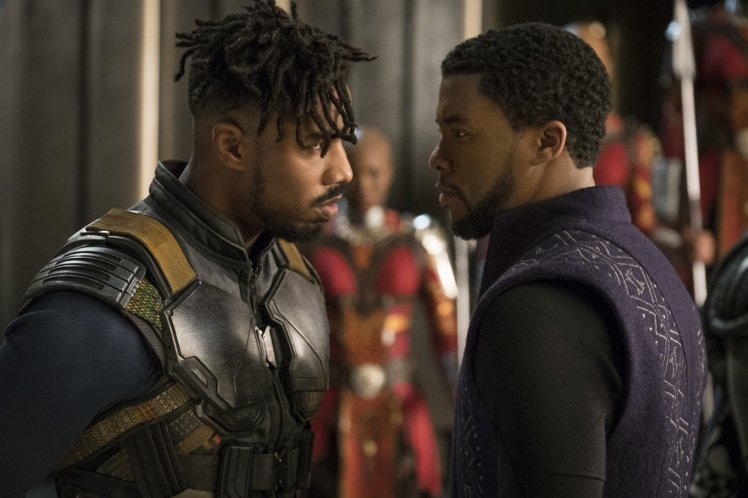To many, the new film “Black Panther” represents a revolution in more than just the Marvel Cinematic Universe, but for cinema as a whole. Being a majority black produced and overseen project, with Ryan Coogler as director as well as writer, assisted by Joe Robert Cole and possessing an almost entirely black cast, including big names like Lupita Nyong’o, Michael B. Jordan, Chadwick Boseman and Angela Bassett, there is no doubt this is a representation of black people that has never been seen before in a mainstream Hollywood blockbuster.
However, there are still those insisting that “Black Panther” is “just another superhero movie,” not unique to those that came before it with the exception of a largely black cast and Afrocentric perspective. However, the representation of black people in media is often, if not always politicized, in general. And since the film is told completely from an Afrocentric narrative, there’s a massive amount of political commentary within it. It just has to be understood with a bit of context.
To understand the film’s political elements, you have to understand a little something about the nature of European colonialism. And whether referencing the actual process or else the continuation of it through modern neo-colonialism, the most important thing to remember is this: Its effects continue to ripple throughout contemporary society, informing social hierarchy, modern politics, class structure, institutional prejudice, political instability within certain regions in Africa and the diaspora and subsequent development of black culture throughout regions globally, including but not limited to the United States.
Here in America, the ripple effect of colonialism and the subsequent centuries of slavery within the region have not only personalized the consequences of it, but also evidently shaped the African-American experience throughout the entirety of the country’s existence from the time the Declaration of Independence was etched into parchment to the present-day, post-Obama America. However, for countries within Africa that had been exploited and bled dry by European powers, the mass chaos that had been wreaking internally and the resulting devastation was irreparable for years to come.
Now enter “Black Panther’s” fictional Wakanda, a country untouched by the greedy, corrupted hands of colonial powers. A place allowed to develop technologically, socially and culturally unaffected by Europe or the Western world. And in that lies the true beauty of the concept behind Wakanda — an homage to our roots, our culture, our ancestors, recognizing the potential for excellence that exists within.
Within Wakanda, black culture is displayed and celebrated. Aspects of tribal aesthetic and traditional African dress, as well as the evident lack of European influence, inform the Afrofuturism aesthetic of the film’s wardrobe, all designed meticulously by the mind of Ruth Carter, “Black Panther’s” costume designer. African-American culture is also referenced frequently, including the seamless weaving in of hip-hop culture when referencing Michael B. Jordan’s character, Erik Killmonger, whose background was notably reflective of that of the modern African American.
However, the wonder of Wakanda extends past cultural elements. Wakanda is in a position of political and technological superiority that European nations usually possessed and often abused for most of the existence of the Western world.
This shapes an intriguing narrative — Wakanda is put into a position to incite a change of monumental proportion — but the change is dependent on a pivotal decision at the root of which is a moral question. As the plot develops, it’s clear there are two possible options revealed regarding the future of Wakanda — help those in need, or else do nothing, play it safe and ensure the security of the nation.
It plays on an age-old moral concept — when you have the ability to incite change, right a wrong or help others that otherwise wouldn’t be able to help themselves, you have the responsibility to do so. However, as the film continues, another option arises with a looming sense foreboding — the potential for a seizure of power and an elimination of any foreign threat. It’s a reversal of roles, in which the once oppressor becomes the one oppressed, colonized by a nation within a continent it once exploited for centuries. The potential Wakanda possesses changes once again, except this time, things have taken a darker turn.
However, this darkness isn’t unfamiliar with the centuries-long struggle for freedom, for the liberation of black people on a global scale. Throughout history, violence and aggression have been used as tools of liberation.
“Black Panther” takes an extremist approach to this, which Erik Killmonger is largely a product of. Killmonger is a metaphor for the experience and struggle of the modern-day African American under systematic oppression and centuries-evolved racism, representative of rage and frustration that is a result of that existence, channeled into violence and destruction. And at surface value, Killmonger seems to fit the profile. Fatherless at a young age, brought up in a rough and unforgiving environment, and channeling a festering rage into a viciousness he unleashes onto society. These are all elements that equate to the stereotype of the “Angry Black Man.” But Killmonger represents something much deeper. Killmonger is a modern revolutionist, an extremist who seizes power ruthlessly and is willing to achieve the liberation of his people by any means necessary.
However noble Killmonger paints his cause against the backdrop of that great struggle of the ancestors who were once enslaved and oppressed, his war is waged on his own terms and victimizes those he claimed to be his own people. Killmonger becomes the thing he swears against — the oppressor, a tyrant. The interesting thing is that he embraces the reversal of these roles with relish. He isn’t hesitant to engage in what he interprets as justice achieved through violence considered deserved. And this is where the sentiment “an eye for an eye” is introduced. However, let us not forget the rest of that saying, as Killmonger would assuredly let the whole world be blinded to fulfill his thirst for revenge.
But, here’s the crazy thing — Killmonger is right. At least, he has the right idea. Because by all rights, what Wakanda has been doing for the past centuries was wrong. Abandoning their own people, letting them be beaten, enslaved and dehumanized, merely watching while the world around them descended into chaos and the lives of people who once shared a home, a culture, a way of life with them were trapped inside a living hell that stretched on for hundreds of years. And if what Wakanda did was bad, what the European powers had done and continued to do in the modern day was absolutely horrendous. In this way, Killmonger isn’t really the bad guy — he’s merely a product of his environment, the way the world has made them.
He takes the only course of action available — overthrow the oppressors, by any means necessary, since Wakanda so obviously isn’t going to. And though his philosophy warps and twists, this sentiment reflects a large portion of the contemporary black community that demands reparations, and even blood for blood for the atrocities inflicted on our people in the past. His perspective on black nationalism and how to rebuild the black community through extreme (and often misguided) means reflects that of what the black community calls a “hotep,” which is an individual who is aggressively pro-black but often anti-progressive and very selective of whom the term “pro-blackness” can apply.
T’Challa’s perspective represents that of an integrationist mindset, reflective of his desire to interact or at least provide aid on a global scale. This is a perspective that differs from that of T’Challa’s father, who believed in isolating Wakanda from global interaction as a way to ensure its safety. In contrast, Killmonger preaches a more extreme philosophy that demands blood for blood, as illustrated by the infamous line “the sun will never set on the Wakanda Empire,” a subversion of what was once said by colonial British powers.
And, after all the violence and cruelty that black people were subjected to in the past, and all the pain that continues to be inflicted on black people globally, who can tell him he is wrong for wanting justice served in the form of vengeance? Let’s not forget the words “an eye for an eye” were written into the pages of the Bible. Looking at it from this perspective, Killmonger is no more the villain than the modern black revolutionist.
In this light, the film doesn’t do him justice by demonizing his character. In fact, in the few scenes where his character is humanized, he is represented as an individual who is misled, a lost cause. This is magnified in one of his last scenes, in which he gazes into a sunset and says, “Throw me in the ocean with my ancestors that jumped off the slave ships because they knew death was better than bondage.” And though he remains the antagonist, Killmonger’s actions also speak largely to the obligation humans have to society to not only help those in need but also to look after their own, to preserve the bonds that both connect and define us.
And so, “Black Panther” intricately weaves together aspects of culture, politics, and principle through an Afrocentric lens. It questions the morality of politics and the political influences of what society considers to be right and wrong. It becomes intricate and deeply nuanced as it incorporates more than just political commentary into its foundations, including the harsh realities of the society we live in, particularly that of black people.
One thing remains clear: “Black Panther” is more than just a superhero movie.
 Erin Davis, 16, attends North Cobb High School and is an aspiring photographer and journalist, who also may or may not have an unhealthy obsession with superhero movies and possess an excessive passion for film.
Erin Davis, 16, attends North Cobb High School and is an aspiring photographer and journalist, who also may or may not have an unhealthy obsession with superhero movies and possess an excessive passion for film.




